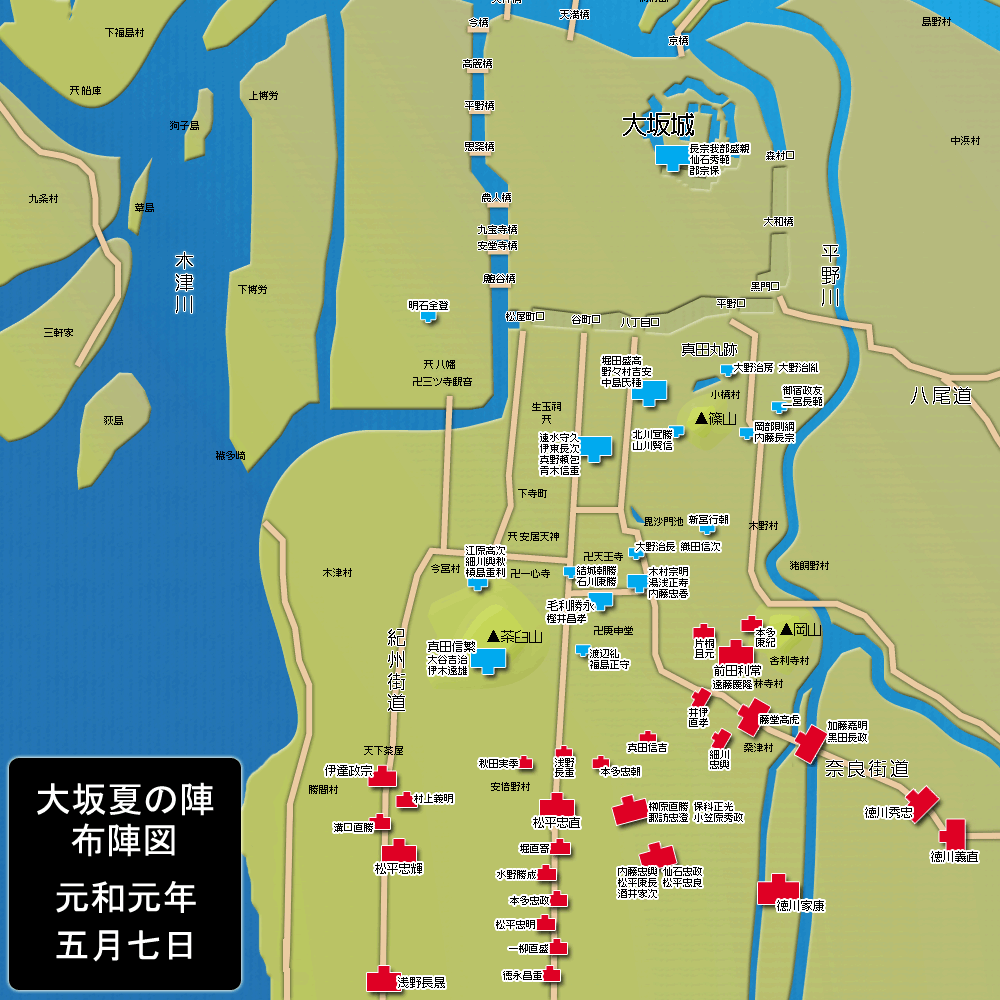Battle of Tennōji on:
[Wikipedia]
[Google]
[Amazon]
 The was fought on 3 June, 1615 between the forces of
The was fought on 3 June, 1615 between the forces of
 The was fought on 3 June, 1615 between the forces of
The was fought on 3 June, 1615 between the forces of Tokugawa Ieyasu
was the founder and first ''shōgun'' of the Tokugawa Shogunate of Japan, which ruled Japan from 1603 until the Meiji Restoration in 1868. He was one of the three "Great Unifiers" of Japan, along with his former lord Oda Nobunaga and fellow ...
and Toyotomi Hideyori
was the son and designated successor of Toyotomi Hideyoshi, the general who first united all of Japan. His mother, Yodo-dono, was the niece of Oda Nobunaga.
Early life
Born in 1593, he was Hideyoshi's second son. The birth of Hideyori cre ...
. Tokugawa was besieging Osaka, and Hideyori had planned a counterattack. Both sides were plagued by mistakes until Hideyori's side finally fell. He presumably committed suicide. The Toyotomi army suffered nearly 50% casualties in this battle, with more than 15,000 dead. This was also the final battle of Sanada Yukimura
, also known as , was a Japanese samurai warrior of the Sengoku period. He was especially known as the leading general on the defending side of the Siege of Osaka.
Yukimura was called "A Hero who may appear once in a hundred years", "Crimson D ...
.
Battle
The last resistance of the Osaka Garrison was at Tennoji, outside of the castle. Hideyori, son of the legendaryToyotomi Hideyoshi
, otherwise known as and , was a Japanese samurai and ''daimyō'' (feudal lord) of the late Sengoku period regarded as the second "Great Unifier" of Japan.Richard Holmes, The World Atlas of Warfare: Military Innovations that Changed the Cour ...
, made up a plan to try and turn the tide of the siege. A council of war
A council of war is a term in military science that describes a meeting held to decide on a course of action, usually in the midst of a battle. Under normal circumstances, decisions are made by a commanding officer, optionally communicated ...
was held on 2 June 1615 and the plan was determined that Sanada, Ōno Harunaga
was a general under Toyotomi Hideyori, and fought in the Siege of Osaka in 1615. He became lord of Osaka castle after the Battle of Sekigahara. Ono led forces against those of Wakayama Castle in the Battle of Kashii, also the Battle of Shigin ...
, and the other commanders would launch an attack to hold the Tokugawa front, while Akashi Morishige
was a Japanese samurai of the Azuchi-Momoyama through early Edo periods. Also known as Teruzumi, Zentō, or Naritoyo. Retainer of Ukita Naoie, the major daimyō of Bizen Province. Also known by his court title, .
Takenori also served as a st ...
would sweep around to attack the rear. In the midst of the rear attack, Hideyori would ride out of the garrison, leading the attack under the banner of Hideyoshi. But the Tokugawa were led by Ieyasu himself, and even though Ieyasu was wounded by a spear thrust, Sanada was killed in action, beheaded by a samurai named Nishio Nizaemon after he sat on a stool to rest. Thus, Morishige's attack failed as well. This left only Hideyori to defend the castle. Ieyasu left Ii Naotaka
was a Japanese ''daimyō'' of the early Edo period who served under the Tokugawa shogunate. He was the son of the famous Tokugawa general Ii Naomasa. His childhood name was Bennosuke (弁之介).
Naotaka served in the Siege of Osaka in his brot ...
to keep watch over the Toyotomi family and secure the castle. Naotaka began to blast the castle with every piece of artillery available and it soon caught fire. Hideyori and his mother Yodo-dono
or (1569 – June 4, 1615) was a prominently placed figure in the late-Sengoku period. She was the daughter of Oichi and sister of Ohatsu and Oeyo. She was a concubine and second wife of Toyotomi Hideyoshi, who was then the most powerful man ...
committed ''seppuku
, sometimes referred to as hara-kiri (, , a native Japanese kun reading), is a form of Japanese ritual suicide by disembowelment. It was originally reserved for samurai in their code of honour but was also practised by other Japanese people ...
''. The eight-year old son of Hideyori, the last of the Toyotomi, was decapitated, along with Chōsokabe Morichika, along with so many rōnin
A ''rōnin'' ( ; ja, 浪人, , meaning 'drifter' or 'wanderer') was a samurai without a lord or master during the feudal period of Japan (1185–1868). A samurai became masterless upon the death of his master or after the loss of his master's ...
that it was said their heads stretched from Kyoto
Kyoto (; Japanese: , ''Kyōto'' ), officially , is the capital city of Kyoto Prefecture in Japan. Located in the Kansai region on the island of Honshu, Kyoto forms a part of the Keihanshin metropolitan area along with Osaka and Kobe. , the ci ...
to Fushimi.
Aside from minor skirmishes, the Battle of Tennōji was the last battle between two great samurai armies ever fought.
References
Tennoji 1615 in Japan Conflicts in 1615 Tennoji {{Japan-battle-stub